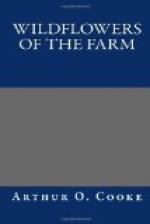[Illustration: BULBOUS CROWFOOT.]
The blossoms of both plants have five smooth shining yellow petals. We see, however, that those of the Bulbous Crowfoot or Buttercup form a real cup, while the petals of the Meadow Crowfoot spread out almost flat. The Meadow Crowfoot grows two or three feet high; the Buttercup is a shorter plant.
The flowers are pretty, but that, I am afraid, is all that we can say for either of these plants. They are both of them bitter and unwholesome, and horses and cattle avoid eating them. Some people even say that to carry a bunch of the stems will make the hands sore; so I think that we will only look at and admire the flowers where they grow.
The Cowslip is a very different plant indeed and we will not call it a weed. Even Mr. Hammond is not sorry to see it here; for he is fond of a glass of the sweet cowslip wine which Mrs. Hammond will make if we busy ourselves and take home some large basketfuls of the drooping blossoms. Before we set to work, however, let us examine the plant.
Looking at a stalk of Cowslip blossoms we see something peculiar about it at once—something unlike the other flowers we have seen. Six or seven drooping blossoms grow from the stalk we have picked, and they all grow from the very top of the stalk. The point at the top of the stalk from which the blossoms grow is called the “umbel.”
Each blossom has five yellow petals joined together to form a corolla. In the centre of the blossom, where these petals meet, each is marked with a spot of deep orange-red colour. The yellow petals are comparatively small, and peep out of a long pale green sheath called the “calyx.”
Surely we have seen a flower like this before—the Primrose in the little coppice. Yes; the Primrose had five pale yellow petals, rather larger than those of the Cowslip, and joined together to form a corolla; they grew out of a long green calyx. Also each petal had a spot of darker yellow in the centre of the blossom. The leaves of both the Primrose and the Cowslip are much wrinkled, and they grow from a short underground stem.
But, you say, each Primrose blossom grew alone on the top of a long stem. Yes, but if we had dug up a Primrose plant, we should have found that several flower stems grew from the same point—the top of a very short stem which hardly appeared above the ground. They grew from an umbel, and the Primrose is closely related to the Cowslip. The difference is that the blossoms of the Primrose grow on long stems from a short-stemmed umbel. Those of the Cowslip grow on short stems from a long-stemmed umbel.
CHAPTER VII
IN THE HAY-FIELD
Here we are in the hay-field at the end of June. It is not really the hay-field yet, but it will be so as soon as the grass is cut for hay. This will be done in a few days, so we must lose no time if we wish to look at some of the flowers before they are cut down.




